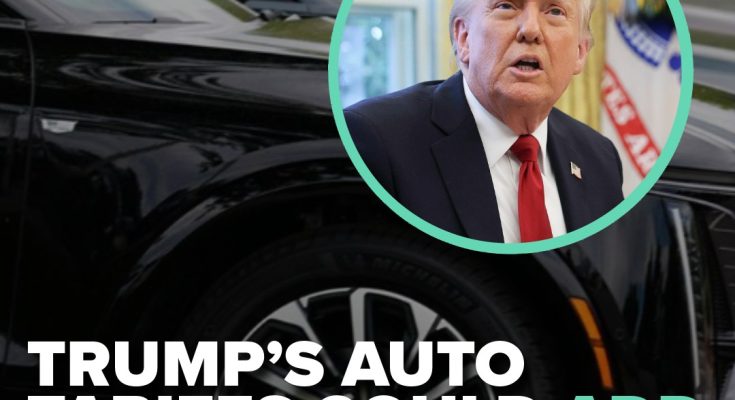WASHINGTON (TNND) — Automakers are facing a series of difficult and expensive decisions as President Donald Trump’s tariffs on foreign cars and parts go into effect in a move that is expected to raise prices for consumers and increase costs beyond the sticker price of a vehicle on the lot.

The tariffs, set to go into effect on April 3, will directly hit vehicles and auto parts imported to the United States that the White House says will apply to “key” parts like engines, transmissions and electric components that could be further expanded.
For now, cars, light trucks and parts that comply with the US-Mexico-Canada trade agreement Trump negotiated five years ago are exempt but could be altered to include vehicles made domestically.
Analysts have warned the changes could quickly lead to increased costs for companies that are likely to be felt by consumers eventually with manufacturers unable to absorb the additional expenses. The tariffs will also impact American companies because their supply chains veer across the country’s borders with suppliers around the world, meaning that few cars are 100% “American-made” and would also be subject to tariffs that lead to price increases.
“It is not immediately clear when the tariff will be imposed on vehicles and inflating the cost of vehicles in inventory, but consumers likely have a narrow window to buy new or used vehicles before prices increase by 10% or more,” Cox Automotive chief economist Jonathan Smoke said on a conference call last week. “If the White House then pursues expanding the scope and applying the 25% duty to parts, we will see a negative impact on U.S. production as well.
“Moreover, with 25% increases in the cost of parts, inflation would surge in maintenance and repair and insurance, which vehicle owners are already struggling to handle.”
Trump has argued that the tariffs on foreign cars and parts will help boost American manufacturing and ultimately restore the U.S. auto industry.
In an interview with NBC, Trump said that he “couldn’t care less” if foreign companies raise their prices.
“I couldn’t care less. I hope they raise their prices, because if they do, people are gonna buy American-made cars. We have plenty,” Trump told NBC News in an interview.
America’s automakers can try several maneuvers to minimize the impact to their sales and operations but many of them are very expensive and carry some long-term risks for operations and may still increase prices for consumers.
Companies could try to reimagine supply chains that are deeply intertwined in Mexico and Canada, increase the number of cars made in U.S. borders, stop selling imported models or build new supply lines and factories across the country — all of which are deeply complicated and expensive options for manufacturers that are not running excessive profit margins.
“It may well be company-specific and supplier-specific, or even part-specific. Auto supply chains are very complex with many layers,” said Z. Justin Ren, associate professor at Boston University’s Questrom School of Business.
Unwinding global supply chains that have been developed over years through trade agreements like the USMCA would take years and cost companies massive sums in additional investments. There is also great uncertainty over whether the investments would pay off long-term with the back-and-forth nature that tariffs have been rolled out and unknowns about whether they will stay in place during the next administration.
The unknowns and uncertainty facing companies could push them to mostly stay put, though some foreign manufacturers have been building factories and supply lines within the U.S.
“I think many companies are taking a wait-and-see approach. But on the other hand, there are also companies that are indeed relocating to the U.S., especially those whose main customer base is in the U.S,” Ren said.
All automakers’ options are also likely to lead to increased prices for consumers once a vehicle hits the lot at a dealership. Estimates on what the impact will be on prices vary but generally run thousands of dollars. Those costs could also keep going up depending on other tariffs Trump implements, such as the “reciprocal” taxes that are being rolled out on Wednesday or a broader trade war if other countries retaliate.
A study by the Yale Budget Lab estimated tariffs would increase vehicle prices by an average of 13.5%, worth another $6,400 to the price of an average new 2024 vehicle.
Dealers could also start pulling back on incentives that give consumers a discount for cars that were produced before the tariffs take effect as existing inventory becomes worth more now that its replacement will be more expensive.
Trump has said the tariffs will push manufacturers to bring jobs back to the United States, a position that has been supported by the United Automobile Workers union that has celebrated the president’s move.
“We applaud the Trump administration for stepping up to end the free trade disaster that has devastated working class communities for decades. Ending the race to the bottom in the auto industry starts with fixing our broken trade deals, and the Trump administration has made history with today’s actions,” UAW President Shawn Fain said in a statement.
The American Automotive Policy Council, a group that represents the Big Three carmakers, said it supported the vision of increasing auto jobs but was cautious about prices.
“U.S. Automakers are committed to President Trump’s vision of increasing automotive production and jobs in the U.S. and will continue to work with the Administration on durable policies that help Americans. In particular, it is critical that tariffs are implemented in a way that avoids raising prices for consumers and that preserves the competitiveness of the integrated North American automotive sector that has been a key success of the President’s USMCA agreement,” said Governor Matt Blunt, president of AAPC.
But there are also concerns that the higher costs could lead to less output from companies as part of the realignment to deal with new costs. Manufacturers could cut production of less popular or profitable models and see sales slump as consumers get priced out of buying a new vehicle and instead get a used one.
Analysts are also projecting the used market could see major increases in costs as a result of the tariffs as more people turn to it to avoid paying a premium on a new vehicle.



